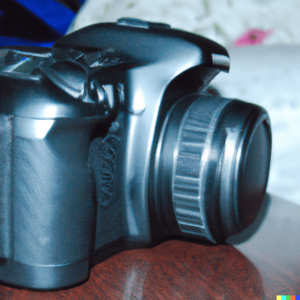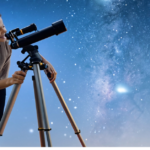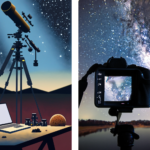Table of Contents
Recently, I’ve been looking at buying a new camera to improve my astrophotography, and I have noticed a large difference in the number of megapixels of various cameras. I’m sure that, as I have asked myself, many others may be wondering, how many megapixels do you need for astrophotography?
In this article, I will try to answer this question in order to help guide you in your choice of camera, be it a dedicated astro camera or a DSLR.

In theory, the larger the number of megapixels a camera has, the better for taking good-quality astrophotography. However, too many pixels may reduce their size and mean that less light is absorbed by each pixel, which will degrade the image. How many megapixels do you need for astrophotography? I’d say around 20–30.
The estimated number of megapixels in a good astrophotography image is merely a guide, and there are other factors that may be just as, if not more, important in a camera that can affect the quality and resolution of an astrophoto. In this article, we will look at this question in more detail and see if we can reach a practical conclusion. This should help you if you are thinking of improving your astrophotography or if you are about to buy a new astronomy camera.
Why is the Number of Megapixels Important?
Most cameras today that we use for astrophotography are digital CCD or Cmos cameras and have an electronics sensor covered with pixels. Each pixel collects light coming from your astrotarget. Our targets are usually very faint, so we need sensitive cameras and long exposure times to collect enough light.
You would think that the more pixels in your sensor, the better, right? That’s more pixels collecting light…
But it is not that simple!
How Many Megapixels Do Different Astrophotography Cameras Have?
First, let’s take a look at some of the most popular cameras used for astrophotography, including both DSLRs and dedicated astro cameras:
| Camera Model | Megapixels | Year |
| Nikon D850 | 45.4 | 2022 |
| Sony A7 III | 24.2 | 2022 |
| Canon 600D | 18 | 2011 |
| Canon EOS 6D MK.2 | 26.2 | 2017 |
| ZWO ASI183 MC PRO | 20.1 | 2021 |
| QHY 8L | 6 | 2010 |
| ZWO ASI533 MC PRO | 9 | 2022 |
| Canon 500D | 15 | 2009 |
From the above table, which does not include all the possible models used for astrophotography, we can see a wide difference in megapixel count, ranging from 6 (QHY 8L) to 45.4 (Nikon D850). Is this a valid comparison of how good a camera is for astrophotography? The simple answer is not really. It helps, but it is not the only important factor in choosing a camera for astrophotography. Is the Sony A6000 any good?
If other factors are taken into consideration and everything is equal, then megapixels may make a difference. But what are the other factors that make the number of megapixels less important?
The Effect the Number of Megapixels Has on Astrophotography
These are the effects of having more megapixels:
- More megapixels are needed if you want to print larger copies of your images, as you need better resolution.
- Given that the sensor is big enough to support more megapixels so that each pixel is big enough to collect enough light, then more megapixels mean better quality photos and more detail.
And here are some points to think about when considering the question: How many megapixels do you need for astrophotography?
- If you have very high-resolution photos, it will become problematic to store these files as they will become very large.
- There is a likelihood that your processing software may not be able to cope with larger files and in any case, it is probable that your computer screen may be limited to about 4 megapixels, (depending on your PC or laptop), making it impossible to process higher resolution images anyway.
- Cameras have different size sensors and you can have a higher megapixel count for a smaller sensor which will not necessarily be ideal, better to consider individual pixel size and the efficiency of each pixel.
The above points highlight the fact that the number of megapixels a camera has is not a good measure of how good it is for astrophotography. In fact, more megapixels can have a negative effect on your photography.
So How Many Megapixels Do You Need for Astrophotography?
Despite what we have said about all the caveats that go with megapixels as a measure of a camera’s ability to take good astrophotos, is there any way to quantify how many megapixels you should look for in a camera?
Looking through various forums and comments from experienced hobbyists and semi-professionals in the astrophotography world we find that:
- Cameras such as the Rebel T1i (Canon 500D) and Canon 5D Mk.III can take great pictures of Astro targets and 15 MP is enough for many.
- The Hubble Telescope is fine with pictures at about 16 MP, so why shouldn’t that be good enough for us? It can do more with its different cameras but this would be a good figure to go with.
- Taking pictures of the Milky Way is quite popular and many claim that great astrophotos can be taken with much lower resolution than the above numbers. There are great examples of Milky Way photos taken with phones at about 9MP or even less.
- Thomas Dalton Ph.D. claims that the number of megapixels is irrelevant for astrophotography. He argues that there are many more important factors involved in taking good astrophotos. I would agree with that!
Why Megapixels Are Less Important Than You May Think
Astrophotography requires technique, technical ability, patience, the right equipment and the ability to get the best out of it, and artistic skills. It also requires a problem-solving attitude and a determination to constantly learn and improve. How important is the number of megapixels in your camera? Not so much when put into perspective.
Much more important factors include the quality of your mount and especially the accuracy of your tracking and guiding setup. Other important factors which contribute to the final quality of the images you produce include your skill as a photographer, your ability to process your images, and your attention to detail in all areas of this hobby/ profession.
How many megapixels do you need for astrophotography? It is of some importance in terms of data capture, but that’s all.
In conclusion, then, how many megapixels do you need for astrophotography? If you’re looking for a number as a guide, I would say anywhere from 9MP upwards will be fine, depending on what your target is. For deep space, in my opinion, it’s not necessary to go beyond 15-20 MP.
After all, you’re not competing with Hubble, that’s impossible, just seek to be happy with what you produce and look to improve on that slowly. Astrophotography is meant to be enjoyed!








